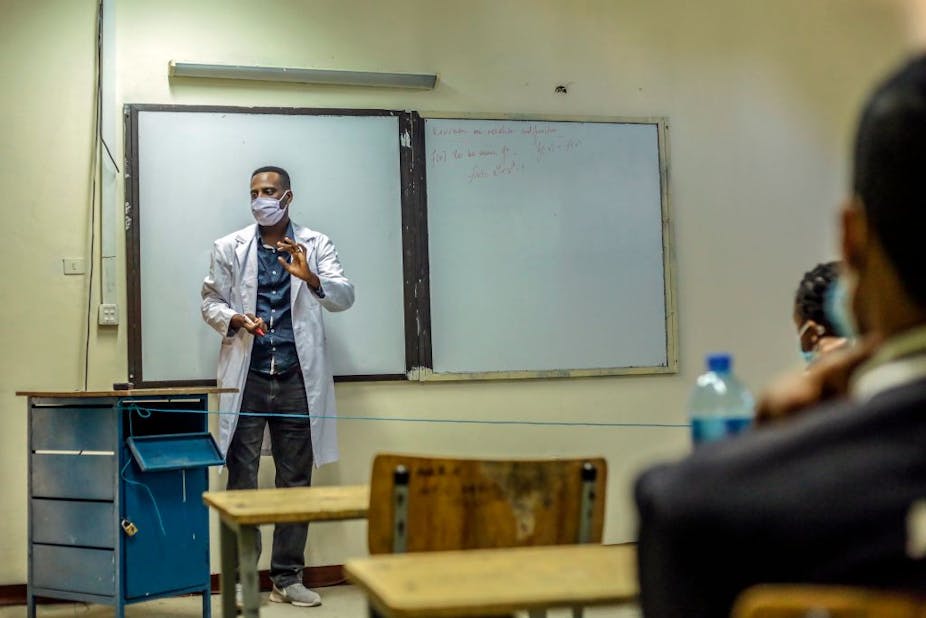Ethiopia’s education sector has seen unprecedented challenges since the onset of the COVID-19 pandemic. Schools and universities were closed for eight months following the confirmation of the first case on March 13, 2020. This put nearly 26 million primary and secondary school students, and around a million tertiary students, out of learning.
Over the past few months, the effects of the pandemic have been pronounced in the private higher education sector whose resource base and capacity is too limited to withstand the impact of a crisis of this magnitude.
Private higher education institutions in Ethiopia draw all their income from student tuition and fees. This heavy reliance has exposed the vulnerability of the sector when the crisis hit and students stopped paying their fees.
I carried out a study which assessed the impact of COVID-19 on Ethiopia’s private higher education sector. The study was conducted through surveys with members of the Ethiopian Technical and Vocational Education and Training (TVET), Higher Education Institutions’ Association and institutions themselves.
I found that the loss of income had severely affected the academic and business operations of institutions. Except for a few months of online training, the first eight months during which institutions were closed were characterised by the interruption of classes and payments.
This is a trend that can be seen in other parts of the continent. For instance private universities in Ghana face serious cash flow challenges with about 50% of students leaving campus with unpaid fees. And in Uganda, many of the countries’ 45 private universities struggled to pay bills, let alone their teaching staff.
To better support private institutions, there must be meaningful assistance by the government and financial institutions. For instance through the provision of tax exemptions, long-term loans, rent waivers or reduction, direct financial support, assistance with online platforms, and reduced internet costs.
I believe that, unless a substantial intervention is made, the sector will be significantly weakened. This could threaten the existence of a sector that supports Ethiopia’s efforts in creating additional access to higher education.
Income and expenses
Ethiopia’s private higher education sector is about 20 years old and today accounts for around 17% of national higher education enrolment. Enrolment is spread over 260 institutions, including five fully-fledged universities.
The landscape is dominated by government-recognised small, for-profit, family-owned institutions. These offer training and award qualifications in technical and vocational, undergraduate and post-graduate programmes to hundred of thousands of students. There are a few non-profits which are generally better resourced, often operated by religious or non-governmental organisations.
My study involved a total of 110 institutions across the whole country. Nearly half of the private institutions are located in Addis Ababa.
I found that private institutions experienced a significant loss of income due to the closure – for most running TVET and undergraduate programs, class was totally interrupted – between June and October, when face to face classes resumed.
Most (73%) of the institutions I examined collected fees on a monthly basis, the remaining 14% collected their fees on a semester basis.
Many of these institutions have an over-reliance on student fees because they don’t have other income sources. Just 2% of the institutions I examined has alternative sources of income to support their operations.
Due to the closure, the strain of paying monthly rent, staff salaries, and other expenses has been a serious challenge. Under normal circumstances, rent and salaries account for more than 75% of monthly expenses. This is because most institutions don’t own the buildings in which they operate.
As a result, I found that many institutions were forced to make late payments, reduce salaries and enter into litigation due to their failure to meet their obligations. A few institutions were forced to reduce the salary of their employees by between 50% and 65%.
Impact on employment
The findings of this study also indicated that many institutions had frozen new employment and stopped employing part-time workers who constitute a significant portion (55%) of the workforce in the private higher education sector. The sector often employs part-timers due to the lack of qualified staff and the cost of having permanent employees.
Another impact of the pandemic on employment was related to the productivity of workers compared to the earlier days. Institutions claimed that the output of their employees was significantly reduced after classes were disrupted. This was mainly due to the interruption of face to face classes and the challenges that needed time for readjustment.
Impact on leadership
My study also revealed the huge burden that leadership within higher education institutions have carried. The suddenness of the pandemic and their poor preparation meant many struggled with their usual role of managing institutional plans and attending to the day to day challenges they face – for instance, not losing experienced staff that weren’t being paid. The declining work ethic among academics and staff, failure to provide accurate information to their community, and fear of the unknown as regards the fate of their institutions have been serious burdens to most institutional leaders.
Many had a feeling of hopelessness. There was limited help from the government and other sources which they think should have bailed them out. But the limited government assistance to the private sector went mostly to other industries including manufacturing, hospitality, horticulture, and floriculture.
While the reopening of schools and universities has provided some hope, the damage the pandemic has caused so far has been great and long-term impacts are still unclear.

